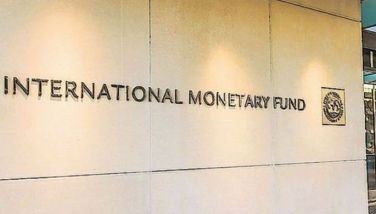Why we may be poor forever

Our politicians don’t take poverty seriously. They say enough to give the impression they are looking after the interest of the poor, but they mostly use the poor as an excuse to steal from the treasury.
Nothing our politicians do actually help the poor get out of poverty for good. Politicians make promises they know they can’t keep, like P20/kg rice.
About half of all Filipinos are poor, according to dependable surveys. For instance, the Social Weather Stations (SWS), which has been tracking poverty in our country for years, reports that 45 percent of Filipino families rated themselves poor in the latest survey conducted from June 28 to July 1.
Octa, another research organization, also reports around half of Filipino families considered themselves poor during the second quarter of this year. The survey, conducted from July 22 to 26, found that half of the total number of Filipino families polled, or around 13.2 million households, rated themselves poor. That’s a big increase in total poor from the estimated 11.3 million families or 43 percent recorded in March.
Octa found that the increase in the number of self-rated poor families is due to significant increases in Visayas and Mindanao. Self-rated poverty rose to 57 percent in the Visayas, and to 59 percent from 45 percent in Duterte’s Mindanao.
Sixty percent of Filipino adults, according to Octa, believe their state of poverty remained the same compared to the previous quarter. They also believe they need to earn at least P20,000 a month for home expenses for them to think they are no longer poor.
It seems the government is undercounting poverty incidence. As of March this year, the government’s latest poverty rate is 13.2 percent of families. Its basis is a threshold income of P12,030 per month for a family of five in 2021. The 13.2 percent is based on the 2021 Family Income and Expenditure Survey (FIES) publicly released in August 2022.
Still, as of Feb. 21, the latest Family Income and Expenditure Survey by the Philippine Statistics Authority (PSA) shows that the majority (58.4 percent) of Filipinos belong to the low-income class, while the middle class comprises around 40 percent of the population. Only 1.4 percent of Filipinos are in the high-income class.
The PSA reports that 18.1 percent of the population lived below the national poverty line in 2021.
An IMF paper written back in 1998 provides a good perspective of why poverty is both more widespread and more persistent in the Philippines than in neighboring ASEAN countries…
“Some of the blame for the Philippines’ slow progress in reducing the incidence of poverty can be attributed to past economic policies that retarded growth by discriminating against agriculture and discouraging investment in human capital. These policies, in turn, sustained powerful interest groups (sugar for instance) that blocked or delayed economic reform.”
Our poverty incidence was not too different from some of our ASEAN peers in the early ‘70s. But our progress in reducing poverty was very slow, so that by the 1990s our poverty rate was dramatically higher than our neighbors.
More specifically, in 1971 Philippine poverty incidence was 52 percent, by 1994 it was 36; Indonesia in 1970 was 58 percent, but by 1990 was 19 percent (slightly higher poverty rate than ours, but by 1990 it was significantly lower than ours even if Indonesia has a lot more population); Thailand in 1962 was 59 percent and by 1988 was 22 percent.
The IMF noted that poverty in the Philippines tends to be associated with low education levels for heads of households and with large family size. Poor Filipinos are disproportionately employed in agriculture, fishing, and forestry: these occupations account for 62 percent of poor households, but for only about 40 percent of the employed labor force. The poor also seem to be disproportionately rural: 60 percent of the poor were living in rural areas in 1991.
The sluggish pace at which the Philippines has reduced poverty over time can be traced to economic policies that hobbled growth… as well as to policies that have more directly perpetuated income inequality.
The IMF noted that “for many years, the Philippines pursued an industrial policy that encouraged import substitution rather than promoting exports… trade policies heavily penalized the primary and agricultural sectors… In addition, the overvaluation of the Philippine peso during several periods between the 1950s and the 1980s contributed to declines in the prices of exports in peso terms and diverted resources away from agriculture and toward inefficient import-substituting manufacturing.
“In addition, incomes in the agricultural sector were depressed by heavy regulation. Beginning in the 1970s, price controls were imposed on rice and other products, and the importation of wheat and soybeans was monopolized. The government introduced controls on the production, marketing, and processing of coconuts…
“Public expenditures on education and health can exert an important influence on poverty and income distribution. Unfortunately, public investment in human capital in the Philippines was both low and inefficiently allocated for many years and, thus, had a limited effect on poverty and inequality.
“Historically, public education in the Philippines has been underfunded relative to other ASEAN countries; central government expenditures on education, both as a percentage of GDP and as a percentage of total government spending, were significantly lower than in Malaysia and Thailand, for example.
Spending on health and nutrition in the Philippines is also relatively low by ASEAN standards. In addition, expenditure has concentrated on expensive, tertiary-level care which lower-income families cannot afford. A World Bank report noted that an optimal allocation of healthcare spending would see the bulk going to primary care whose impact (in terms of reducing mortality rates) is much greater.
Fast forward to 2023: In next year’s budget, the Philippine General Hospital, the primary go-to hospital of the poor for quality care, is getting zero budget for capital outlay to improve and expand its facilities. VP Sara Duterte, on the other hand, is getting P650 million in confidential funds. That’s how crappy our politicians think.
The 1998 IMF paper reads like it was written today. Same problems. It answers the question why we remain poor and may remain poor forever unless we get serious in fighting poverty.
Boo Chanco’s email address is [email protected]. Follow him on X (Twitter) @boochanco
- Latest
- Trending




























